Pangasinan town’s 400-year history packed in museum
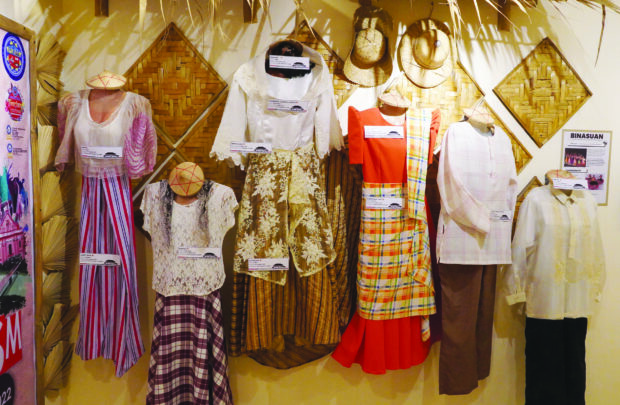
FASHION | A gallery is devoted to traditional, authentic Filipino wear labeled, when appropriate, in the Pangasinan language. All items found in the two-story Bayambang Museum Home of Innovation have been donated. It took years of planning and curating historical articles before the museum was finally opened to the public in October 2022. (Photo by RAY ZAMBRANO / Inquirer Central Luzon)
BAYAMBANG, Pangasinan, Philippines — Every day, curious students from this agricultural town queue at the Bayambang Museum, almost innocent about their community, to embark on a journey of discovery.
And each time they come face-to-face with the exhibits, it is as if a curtain is lifted in front of their eyes and they see for the first time the great history and heritage of their town.
“I did not know that our town has a rich history, that it was once the country’s seat of power, that its first name was Malunguey, and that it has contributed to the national culture through dance and music,” said Ericka Inocencio, a third-year Bachelor of Science in secondary education student at the Pangasinan State University campus here.
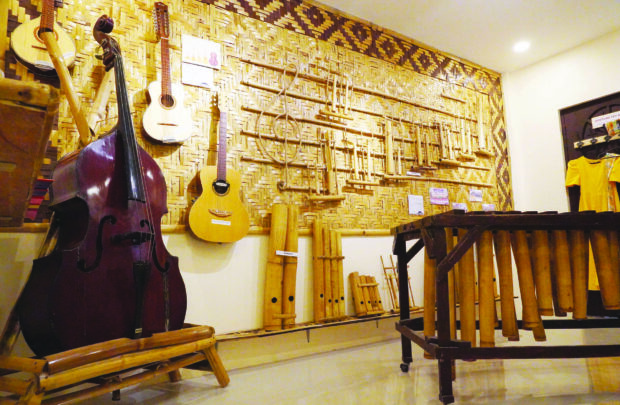
TOWN LIFE | On display in the first gallery are musical instruments, such as the marimba, “anklung” and “bumbong,” all donated by the late professor Rufino Menor who headed the Pangkat Kawayan of the Pangasinan State University. (Photo by RAY ZAMBRANO / Inquirer Central Luzon)
Even elementary students are learning from the museum, like Jirah Mae Magat, a Grade 2 pupil at Amanperez Elementary School, who could not help but stare at the colorful traditional clothes on display in the first gallery.
Inocencio and Magat have visited the museum, which is run by the local government, several times already, always expressing their amazement in every visit, said Ray Hope Bancolita, a staff member of the town museum office.
Article continues after this advertisementThe two-story Bayambang Museum Home of Innovation, built in front of the town plaza, took years of planning and curating historical articles before it was finally opened to the public in October 2022.
Article continues after this advertisementResty Odon, Bayambang tourism officer, said the museum was actually a brainchild of former Mayor Cesar Quiambao and his wife, Nina, the incumbent mayor. He said while plans for the museum started in 2016, actual construction began in 2021 although its completion was delayed by several factors, including the COVID-19 pandemic.
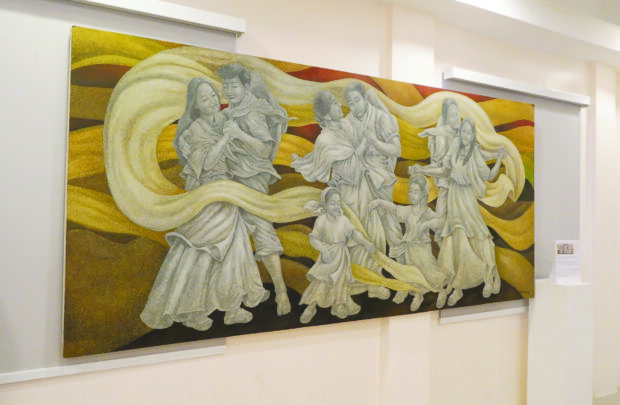
A painting called “Baile” depicts the nightlong party that locals hold to celebrate major life events. (Photo by RAY ZAMBRANO / Inquirer Central Luzon)
“The people’s awareness of local history is low, and Bayambang residents are no different. Through the museum, we hope that the young people would know about the history of their 400-year-old town and would instill in their hearts and minds, love and pride for the town,” Odon shared.
Fusion
Old and contemporary history are fused together in the museum’s five galleries, giving residents and visitors a glimpse of this agricultural town’s rich heritage and unique culture and traditions.
“We call it Home of Innovation because it highlights the advancements made by the town since its founding in 1614,” Odon said.
The first gallery features the town’s “various contributions to the nation’s culture and the arts scene,” including the “binasuan dance” with drinking glasses balanced on the head and hands, which originated in Bayambang. The dance is similar to the “pandanggo sa ilaw.”
Several musical instruments made of wood and bamboo, such as the marimba, “angklung” and “bumbong” which were donated by Pangkat Kawayan of the Pangasinan State University, are also on display.
In the same gallery are the traditional clothing of Filipinos of yore: “baro’t saya” for women and barong Tagalog for men.
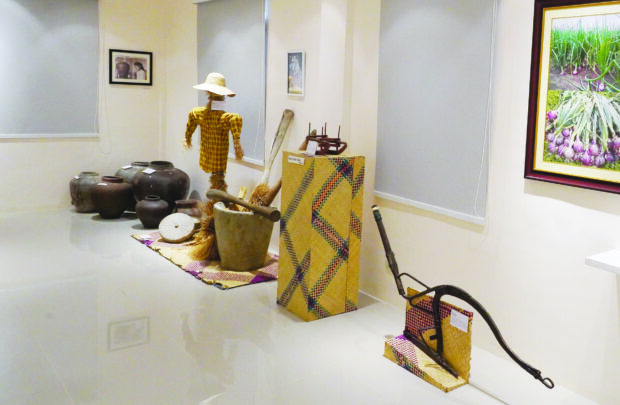
The agricultural roots of Bayambang is represented by an exhibit of farm tools and traditional pottery. (Photo by RAY ZAMBRANO / Inquirer Central Luzon)
“Those who want to can wear this pair of traditional clothing for picture taking. Don’t worry, these are washed daily,” said Bancolita.
At the lobby before the entrance to the first gallery is a framed black “balintawak” and “alampay” that dates back to 1922 and was donated by Severa Ramos Gomez Manganan.
Balintawak is a native butterfly-sleeved blouse with an accompanying shawl (alampay) that Manganan wore during formal occasions.
The abaca-made, elegantly embroidered balintawak is paired with a long skirt called “sapey,” or saya, in Filipino.
Bayambang’s rich history is presented in the second gallery, starting with the very first name of the town, “Malunguey,” when it was founded in 1614, or more than 400 years ago, when it was “a “flourishing settlement of native inhabitants” along the mighty Agno River.
The brochure, “Bayambang through the years,” describes the town as still agricultural which has survived the raves of time from the economic and cultural impact of colonization to the natural and man-made destruction of modern times. The town actively participated in uprisings against the Spaniards.
READ: Leyte to transform historic capitol into museum
READ: Sugar museum to rise in Negros Occidental
READ: Up close with national artists in this Pampanga museum
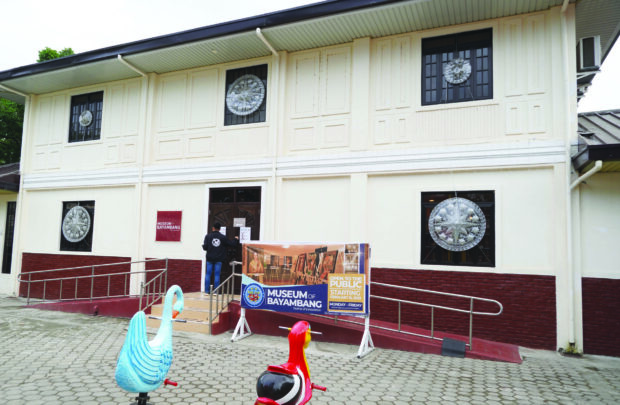
ACCESSIBLE | The building that houses the museum was originally conceptualized to remind locals and visitors of a typical “bahay na bato” during the colonial period. (Photo by RAY ZAMBRANO / Inquirer Central Luzon)
Revolt, education
A framed timeline showed that in 1660, locals organized a revolt against the Spaniards, which was immediately quelled by the conquerors.
Two months later, the Malong Revolt, led by Andres Malong, broke out, and residents joined him in their “disgust over the excesses of the Spanish authorities.”
Another gallery focuses on education, with most residents unaware that the town was a “trailblazer” in education and that “old schools” were established in the town decades ago. One is the Pangasinan Normal School, which was founded in 1922 and eventually became a part of the Pangasinan State University system. Then there’s Bayambang Central School, built in 1914.
Another feature of the museum is the “Persons of Innovation” gallery, which shows important personalities from the town, including fashion designer Rusty Lopez; jazz artist and musician Ronaldo Torres; entrepreneur, philanthropist and former Mayor Cezar Quiambao; educator Clarita Jimenez; and filmmaker and artist Christopher Gozum.
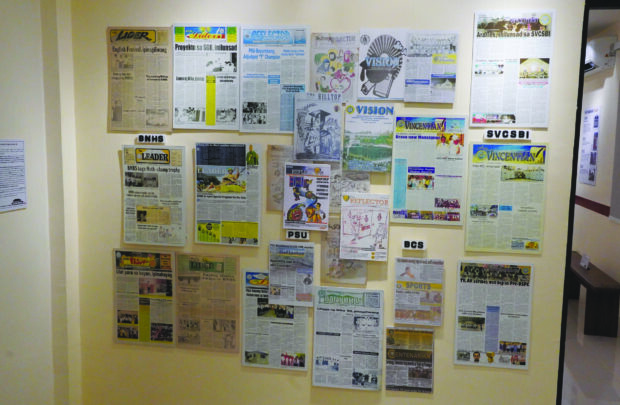
IN THE NEWS | A wall in the Education Gallery displays different publications released by local schools throughout the years. (Photo by RAY ZAMBRANO / Inquirer Central Luzon)
The town is also known as a top producer of onions in the Ilocos region, with 1,500 hectares of agricultural land producing around 100,000 metric tons of the vegetables annually, records from the agriculture office showed.
Bayambang has actually earned the moniker “onion capital of northern Luzon,” aside from being the “corn belt of Pangasinan,” because of its massive production of the crop. Photos of the vast onion farmlands and agricultural implements are on display in the agriculture gallery.
Through a collection of items, video, audio and interactive displays, the exhibits show how Bayambang has grown from its bucolic roots to a modern community.
The museum, according to local officials, is envisioned to become a venue where residents “share gathered and verified information about the innovations that shaped Bayambang into the town that it is today.”